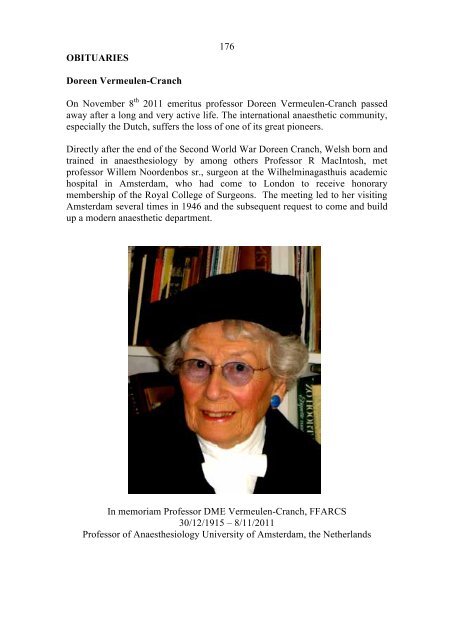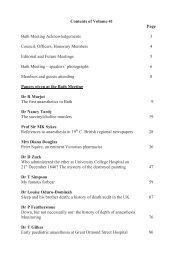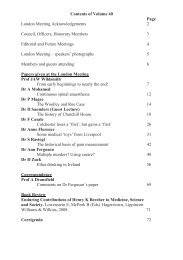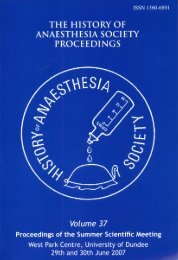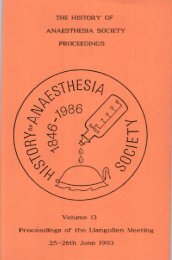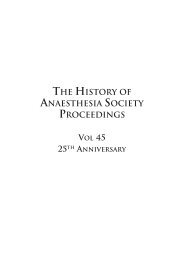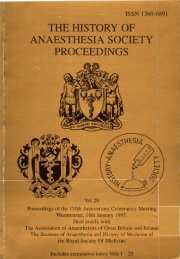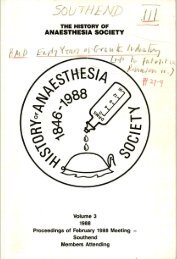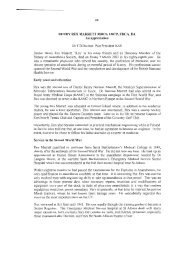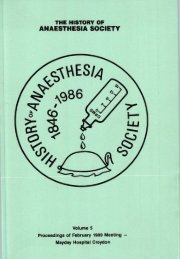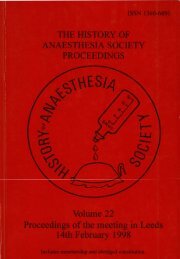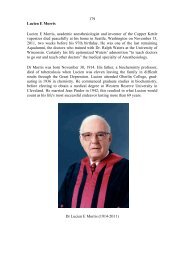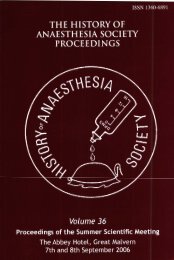Professor DME Vermeulen-Cranch - History of Anaesthesia Society
Professor DME Vermeulen-Cranch - History of Anaesthesia Society
Professor DME Vermeulen-Cranch - History of Anaesthesia Society
Create successful ePaper yourself
Turn your PDF publications into a flip-book with our unique Google optimized e-Paper software.
OBITUARIES<br />
176<br />
Doreen <strong>Vermeulen</strong>-<strong>Cranch</strong><br />
On November 8 th 2011 emeritus pr<strong>of</strong>essor Doreen <strong>Vermeulen</strong>-<strong>Cranch</strong> passed<br />
away after a long and very active life. The international anaesthetic community,<br />
especially the Dutch, suffers the loss <strong>of</strong> one <strong>of</strong> its great pioneers.<br />
Directly after the end <strong>of</strong> the Second World War Doreen <strong>Cranch</strong>, Welsh born and<br />
trained in anaesthesiology by among others <strong>Pr<strong>of</strong>essor</strong> R MacIntosh, met<br />
pr<strong>of</strong>essor Willem Noordenbos sr., surgeon at the Wilhelminagasthuis academic<br />
hospital in Amsterdam, who had come to London to receive honorary<br />
membership <strong>of</strong> the Royal College <strong>of</strong> Surgeons. The meeting led to her visiting<br />
Amsterdam several times in 1946 and the subsequent request to come and build<br />
up a modern anaesthetic department.<br />
In memoriam <strong>Pr<strong>of</strong>essor</strong> <strong>DME</strong> <strong>Vermeulen</strong>-<strong>Cranch</strong>, FFARCS<br />
30/12/1915 – 8/11/2011<br />
<strong>Pr<strong>of</strong>essor</strong> <strong>of</strong> Anaesthesiology University <strong>of</strong> Amsterdam, the Netherlands
177<br />
In the mean time she married the Dutch merchant marine <strong>of</strong>ficer G. <strong>Vermeulen</strong>,<br />
who had survived two torpedoed ships during the war and was later to become<br />
director <strong>of</strong> the Royal Dutch Steamboat Company (KNSM) in Amsterdam.<br />
At that time, contrary to the situation in the United Kingdom, there were no<br />
specialist anaesthetists in The Netherlands. Surgeons let their most junior<br />
assistant or a nurse apply very basic anaesthetics. Dutch pr<strong>of</strong>essors <strong>of</strong> surgery<br />
who visited the UK after the war saw the advantages that more advanced<br />
pr<strong>of</strong>essional anaesthesia provided.<br />
The barely thirty year old young doctor (to look older she pinned up her hair)<br />
made “the jump to the continent” to enter the strongly conservative, masculine<br />
and hierarchal world <strong>of</strong> Dutch surgery. She was accompanied by her great lead<br />
in knowledge and a famous small case with modern equipment.<br />
With her knowledge, but especially her gift for tactical communication, a great<br />
deal <strong>of</strong> modesty mixed with pr<strong>of</strong>essional determination and feeling for existing<br />
relationships she managed to modernize the anaesthetic departments <strong>of</strong> her own<br />
and several other hospitals in Amsterdam and even in Utrecht. Where before<br />
open ether masks and unprotected airways led to limited possibilities and<br />
sometimes dangerous situations, she introduced endotracheal intubation making<br />
intrathoracic surgery possible. She also introduced the routine application <strong>of</strong> an<br />
intravenous drip in all operation patients, intravenous hypnotics, brand new<br />
curare and analgesics; the concept <strong>of</strong> mono-anaesthesia went overboard. The<br />
introduction <strong>of</strong> routine pre-operative evaluation, recovery room facilities and<br />
intensive care department, including one for neonates, were also <strong>of</strong> her doing.<br />
Exceptional was her initiative to train nurses as specialised anaesthetic<br />
assistants, and the institution <strong>of</strong> a departmental technical instrument maker.<br />
Before long the surgeons, who formerly claimed not to need anaesthetists, were<br />
rolling out the red carpet for the charming Welsh newcomer. Later in her career<br />
she championed sedation techniques for dental surgery and for the mentally<br />
handicapped.<br />
<strong>Pr<strong>of</strong>essor</strong> I. Boerema, head <strong>of</strong> the Surgical Academic Unit in the<br />
Wilhelminagasthuis asked her to implement an anaesthesia specialist training<br />
program in 1947. Her first pupils Boeré and Mauve were general practitioners in<br />
their thirties, later to lead academic departments <strong>of</strong> their own. She was<br />
appointed lecturer in 1951, and in 1958 her installation as pr<strong>of</strong>essor made her<br />
the first in the field <strong>of</strong> anaesthesia on the European continent. Many future<br />
heads <strong>of</strong> Dutch academic departments were to be trained by her. She stimulated<br />
the institution <strong>of</strong> the Dutch Anaesthetists <strong>Society</strong> (NVA) in 1948 and <strong>of</strong> the
178<br />
World Federation <strong>of</strong> Societies <strong>of</strong> Anaesthesiologists during its first congress in<br />
The Hague in 1955. Up to her retirement in 1984 she was the educator <strong>of</strong><br />
countless trainees and trusted advisor to many surgical colleagues dealing with<br />
difficult problems. Under her supervision the specialty <strong>of</strong> anaesthesia in the<br />
Netherlands grew and developed into what it has now become. Her valedictory<br />
lecture was titled “Emancipation process”. Herself a fully emancipated woman,<br />
who inspired many female pr<strong>of</strong>essionals, she was responsible for the<br />
emancipation <strong>of</strong> anaesthesia in the Dutch academic world.<br />
Up to the summer <strong>of</strong> 2011 she retained an active interest in the pr<strong>of</strong>ession, being<br />
guest <strong>of</strong> honour at the European <strong>Society</strong> <strong>of</strong> <strong>Anaesthesia</strong> congress in Amsterdam<br />
in June. She continued to visit the annual meetings <strong>of</strong> the Dutch <strong>Society</strong> to<br />
attend the opening lecture which is named in her honour. Always she had a<br />
relevant remark to make. As travelling abroad became more troublesome she<br />
regretfully could not visit pr<strong>of</strong>essional meetings, especially those <strong>of</strong> the <strong>History</strong><br />
<strong>of</strong> <strong>Anaesthesia</strong> <strong>Society</strong>.<br />
In honour <strong>of</strong> her many achievements she was awarded Commander <strong>of</strong> the<br />
British Empire and Knight <strong>of</strong> the Order <strong>of</strong> the Dutch Lion. The anaesthetic<br />
societies <strong>of</strong> both the UK and the Netherlands made her honorary member.<br />
Her famous case, painting and many other attributes remain in honour <strong>of</strong> her<br />
memory in the Historic museum <strong>of</strong> the <strong>Anaesthesia</strong> Department <strong>of</strong> the<br />
Amsterdam Academic Medical Centre.<br />
We remember her as an exceptional person and especially a warm personality.<br />
Jan Eshuis, anaesthesiologist Amsterdam


